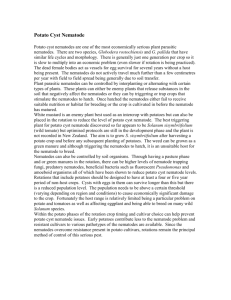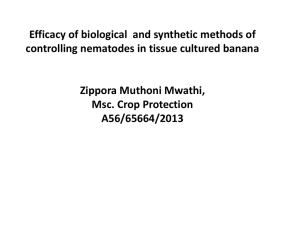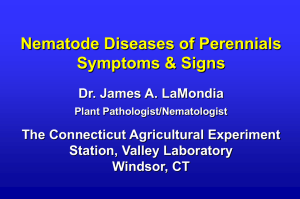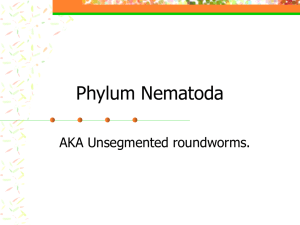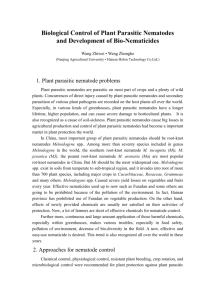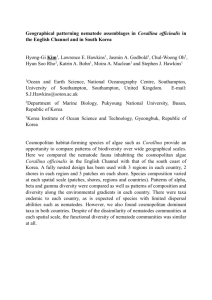biological antagonists and biological control of nematodes
advertisement
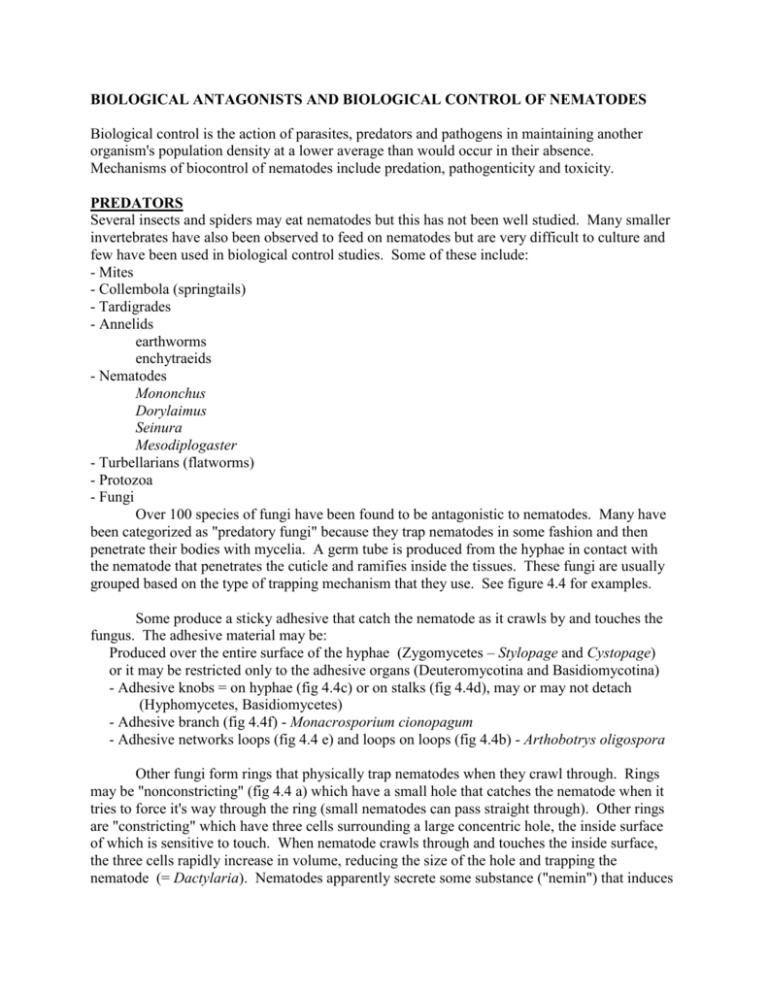
BIOLOGICAL ANTAGONISTS AND BIOLOGICAL CONTROL OF NEMATODES Biological control is the action of parasites, predators and pathogens in maintaining another organism's population density at a lower average than would occur in their absence. Mechanisms of biocontrol of nematodes include predation, pathogenticity and toxicity. PREDATORS Several insects and spiders may eat nematodes but this has not been well studied. Many smaller invertebrates have also been observed to feed on nematodes but are very difficult to culture and few have been used in biological control studies. Some of these include: - Mites - Collembola (springtails) - Tardigrades - Annelids earthworms enchytraeids - Nematodes Mononchus Dorylaimus Seinura Mesodiplogaster - Turbellarians (flatworms) - Protozoa - Fungi Over 100 species of fungi have been found to be antagonistic to nematodes. Many have been categorized as "predatory fungi" because they trap nematodes in some fashion and then penetrate their bodies with mycelia. A germ tube is produced from the hyphae in contact with the nematode that penetrates the cuticle and ramifies inside the tissues. These fungi are usually grouped based on the type of trapping mechanism that they use. See figure 4.4 for examples. Some produce a sticky adhesive that catch the nematode as it crawls by and touches the fungus. The adhesive material may be: Produced over the entire surface of the hyphae (Zygomycetes – Stylopage and Cystopage) or it may be restricted only to the adhesive organs (Deuteromycotina and Basidiomycotina) - Adhesive knobs = on hyphae (fig 4.4c) or on stalks (fig 4.4d), may or may not detach (Hyphomycetes, Basidiomycetes) - Adhesive branch (fig 4.4f) - Monacrosporium cionopagum - Adhesive networks loops (fig 4.4 e) and loops on loops (fig 4.4b) - Arthobotrys oligospora Other fungi form rings that physically trap nematodes when they crawl through. Rings may be "nonconstricting" (fig 4.4 a) which have a small hole that catches the nematode when it tries to force it's way through the ring (small nematodes can pass straight through). Other rings are "constricting" which have three cells surrounding a large concentric hole, the inside surface of which is sensitive to touch. When nematode crawls through and touches the inside surface, the three cells rapidly increase in volume, reducing the size of the hole and trapping the nematode (= Dactylaria). Nematodes apparently secrete some substance ("nemin") that induces trap formation. There is also some evidence that fungi produce substances that attract nematodes. PATHOGENS Protozoa Viruses Bacteria Myxobacteria – only affect rhabditid nematodes, not plant pathogens, cuticle differences Pasteuria (bacillus) penetrans = one of most pathogenic and used in many biological control studies. Produces spores that attach to cuticle of juvenile and (30%) germinate about 8 days after nematode penetrates root system. Germ tube penetrates cuticle and forms spherical, dichotomously branched "thalli" or microcolonies that fragment to daughter colonies. These continue to proliferate in pseudocoelum and eventually fill body cavity of developing female. Females decompose and liberate spores that may remain dormant for long periods until contacted by another nematode. Fungi Fungi that do not produce hyphal networks through the soil but produce spores (usually zoospores) with adhesive which stick onto passing nematodes are usually referred to as parasitic or pathogenic fungi. - Endoparasites with ingested conidia (Harposporium) plant pathogenic nematodes unaffected. - Endoparasites with encysting zoospores (motile spores) - Catenaria anguilulae Usually the spore forms a germ tube that penetrates cuticle to form hyphae that "dissolve" nematode and eventually forms zoosporangia inside the nematode. Zoospores leave the nematode body through an exit tube and swim (flagellated) or crawl (amoeboid) through soil. - Endoparasites with adhesive spores (nonmotile spores) - Hirsutella rhossiliensis Small spores, limited energy reserves, don’t produce extensive hyphae in soil, probably dependent on nematodes as a food source = obligate parasites. Produces nonmotile spores which adhere to, penetrate and infect passing nematodes in the soil. Hyphae grow throughout the still living nematode until, in a few days the nematode is dead and filled with hyphae. Fungus emerges from cadaver and sporulates. - Obligate pathogens of females - Catenaria auxiliaris, Nematophthora gynophila Attacks female cyst nematodes, destroys cuticle body wall internal tissues and eggs. "Cyst" is not formed. Body loses turgor and is filled with spores in 4 days. -Egg parasites: Paecilomyces lilacinus, Dactylella oviparasitica, Verticillium chlamydosporium Some fungi are egg parasites. Paecilomyces lilacinus attacks egg masses and sometimes enters female through vulva or anus and can kill female. Nematodes which lay their eggs in groups (sedentary parasites) are more vulnerable then migratory forms. Once in contact with eggs the fungus spreads quickly and parasitizes all eggs in stages of embryonic development, = less effective once there is a juvenile within the egg. Fungus has chitinase enzymes, chitin is in egg shells but not in cuticle. Nematoxins Clostridium pasteurianum and C. butyricum = anaerobic -> produces toxin in saturated soils that attacks cuticle -> paralyze then decompose. Desulfovibrio desulfuricans – produces H2S in rice fields Bacillus thuringiensis – produces toxin that reduces fecundity and egg hatch Streptomyces avermitilis – produce avermectins, potent broad-spectrum nematicidal properties Nematoctonus sp. – germinating spores secrete nematoxins, = rapid immobilization and death. Paecilomyces lilacinus - metabolites or enzymes diffuse into egg and affects development. Penicillium anatolicum – compounds alter permeability of egg shell, eggs hatch prematurely

